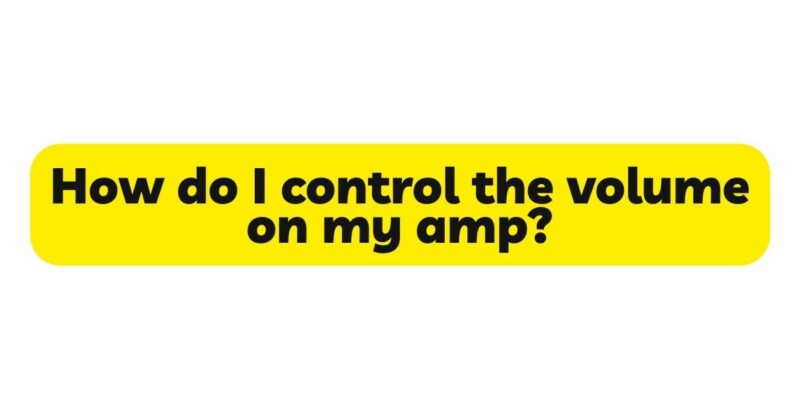Controlling the volume on your amplifier is a fundamental aspect of achieving the desired sound levels for your music. Whether you’re a guitarist, a musician, or an audio enthusiast, understanding how to effectively manage volume on your amp is essential for achieving optimal sound quality, maintaining balance in a mix, and ensuring a comfortable listening experience. In this article, we will delve into the various methods and techniques for controlling the volume on your amp, providing you with the knowledge to take charge of your sound.
- Know Your Amp’s Controls: The first step in mastering volume control is to familiarize yourself with the controls on your amplifier. Different types of amplifiers may have varying control layouts, but there are common features you’ll find on most amps:
a. Volume: The volume control regulates the overall loudness of the amplifier. Turning it clockwise increases the volume, while turning it counterclockwise decreases it. This control directly affects the output level of your amp.
b. Gain: The gain control, often found on guitar amplifiers, determines the level of preamp distortion. It affects the tonal character and sustain of your sound. Adjusting the gain can impact both volume and tone.
c. Master Volume: Some amplifiers, particularly those with separate gain and master volume controls, feature a master volume control. This control regulates the overall output level after the preamp stage. Adjusting the master volume allows you to control the overall loudness without affecting the preamp gain.
- Start with a Balanced Gain Structure: Achieving the desired volume and tone begins with establishing a balanced gain structure. This involves setting appropriate levels at each stage of your signal chain, from the instrument to the amplifier. Ensure that the gain levels on your instrument, pedals, and amp are appropriately set to avoid excessive clipping or distortion.
- Adjust the Volume Control: The most straightforward way to control the volume on your amp is by adjusting the volume control. Start by setting the control at a comfortable level and gradually increase or decrease it to achieve the desired volume. Keep in mind that excessive volume settings can result in distortion or even damage to your speakers, so exercise caution when pushing the limits.
- Utilize the Master Volume Control: If your amp has a separate master volume control, it offers an additional level of control over the overall output. By adjusting the master volume, you can fine-tune the loudness without affecting the preamp gain. This can be especially useful for achieving a desirable volume while maintaining a particular tonal character.
- Employ Attenuators or Power Soaks: Attenuators or power soaks are devices that sit between your amp and speakers, allowing you to reduce the output power while preserving the tone and characteristics of your amp. These devices enable you to push your amp harder at lower volume levels, which can be beneficial for achieving desired tonal qualities without excessive volume. Attenuators often feature volume controls to adjust the output level to your preference.
- Use a Volume Pedal: A volume pedal is a foot-operated device that allows you to control the volume in real-time. It can be placed in your signal chain before the amp or in the amp’s effects loop. By manipulating the pedal’s position, you can smoothly increase or decrease the volume during a performance, providing dynamic control over your sound.
- Employ Built-in Effects or External Pedals: Some amplifiers offer built-in effects, such as boost or overdrive, which can be used to increase the volume selectively. These effects can be engaged to provide a temporary volume boost when required. Additionally, using external volume-boosting pedals can further enhance your ability to control the output volume on your amp.
- Explore Power Scaling or Switchable Power Modes: Certain amplifiers feature power scaling or switchable power modes that allow you to adjust the overall power output. This can be particularly useful when playing in different environments or situations that require lower volume levels. By reducing the output power, you can attain desired tonal characteristics and saturation at more manageable volume levels.
- Employ Attentive EQ and Tone Shaping: Tone controls and equalizers (EQ) on your amp can impact the perceived volume and tonal balance. By adjusting the bass, midrange, and treble controls, you can shape the sound to cut through the mix or blend in seamlessly. Experimenting with these controls can help you find the sweet spot where the volume sits optimally in relation to the desired tone.
- Be Mindful of Your Environment: Lastly, it’s crucial to consider your listening environment when controlling the volume on your amp. Different venues or spaces may have specific restrictions or requirements regarding volume levels. Respect these guidelines to ensure a positive experience for both yourself and those around you. If needed, utilize isolation booths, soundproofing, or personal monitoring systems to tailor the volume to your specific needs without causing disturbances.
Conclusion: Controlling the volume on your amp is a skill that requires understanding your equipment and implementing various techniques effectively. By familiarizing yourself with your amp’s controls, achieving a balanced gain structure, and utilizing volume controls, master volume, or attenuators, you can attain the desired volume levels while maintaining tone and clarity. Employing volume pedals, effects, EQ, and being mindful of your environment further enhances your control over the output. With these techniques in your arsenal, you can confidently navigate the world of volume control, allowing you to shape your sound and create memorable musical experiences.


